Abstract
The objective of this study was to evaluate the use of the serum creatinine in following postoperative renal function. In this prospective study of 278 patients (mainly hypertensives and diabetics) undergoing noncardiac surgery, the serum creatinines were followed from the first through the sixth postoperative day. Creatinine clearances were evaluated before operation and on the fourth to fifth postoperative day. During the first six days after the operation, 23% (65 of 278 patients) had an increase of serum creatinine greater than or equal to 20%. Such increases were sustained for greater than or equal to 48 hours in 12% of the patients (32 of 278), and half of these patients had not returned to their initial level of renal function by the time of discharge. Patients who sustained such a deterioration were at risk for nonoliguric renal failure if they had a subsequent insult (i.e., hypotension, reoperation, angiography, aminoglycosides). Such increases occurred early in the postoperative period--on the first or second postoperative day. As judged by the creatinine clearances, postoperative increases of greater than or equal to 20% in the serum creatinine identified most patients whose clearance fell more than 50%, although the serum creatinine did not accurately reflect changes in creatinine clearance among those patients who had undergone an amputation. It is concluded that the serum creatinine is useful in monitoring postoperative renal function. Of those patients who had postoperative increases in serum creatinine sustained for greater than or equal to 48 hours, as many as one third had evidence of impairment in renal function at the time of discharge.
Full text
PDF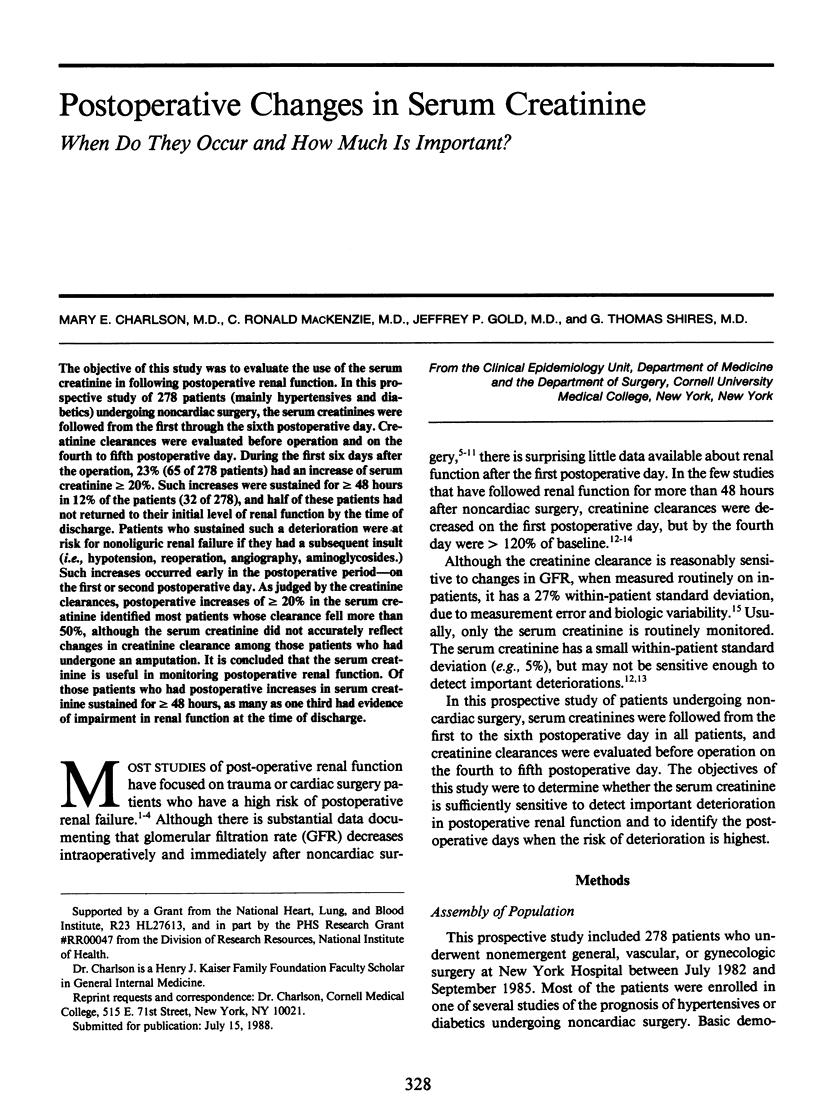
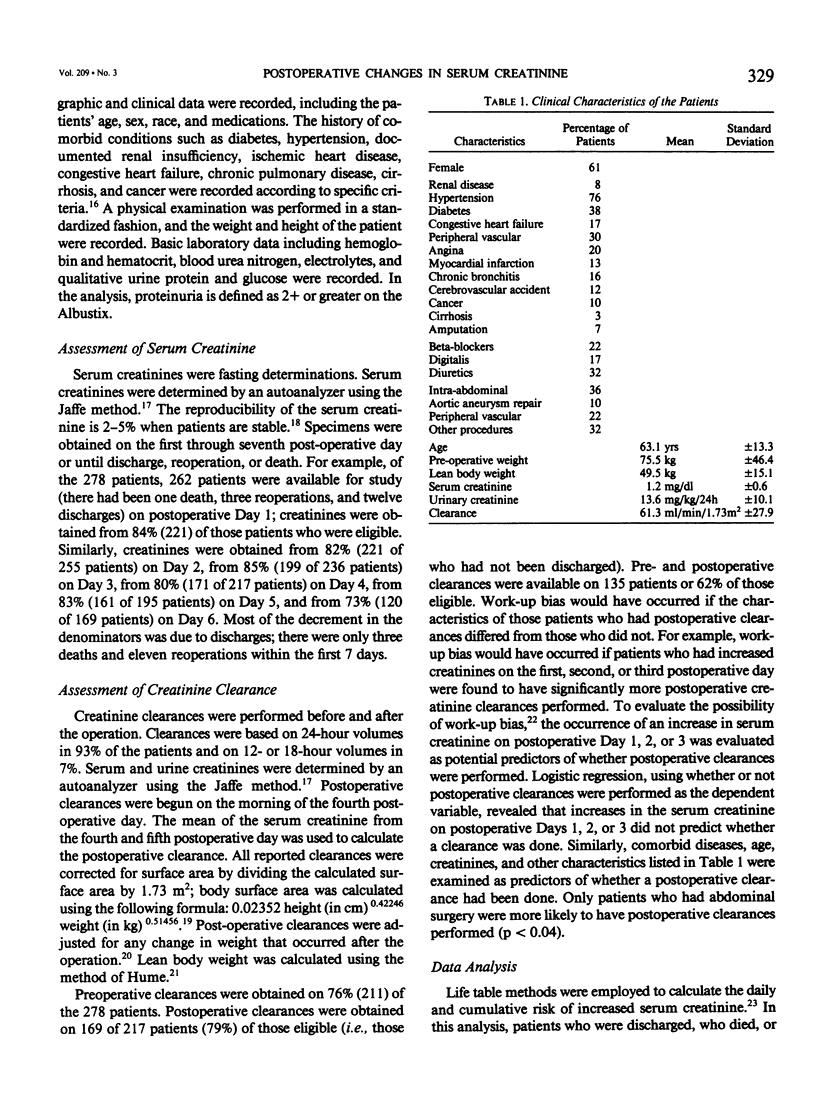
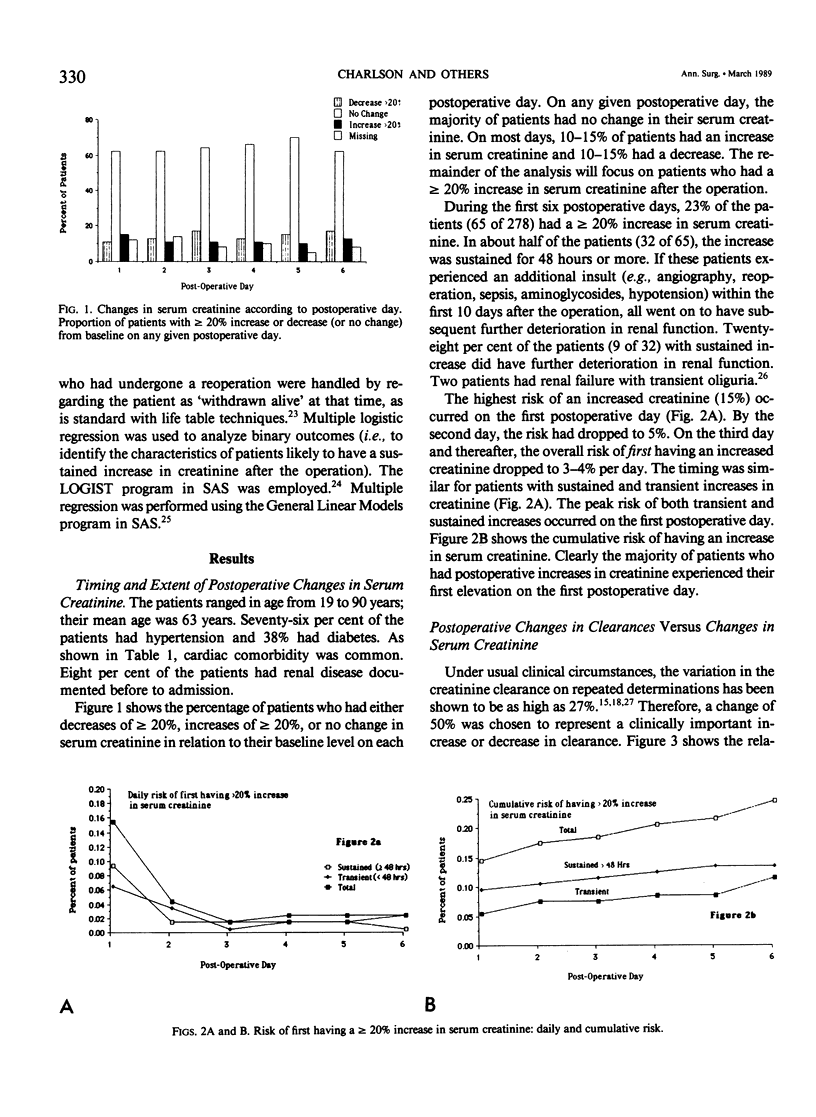
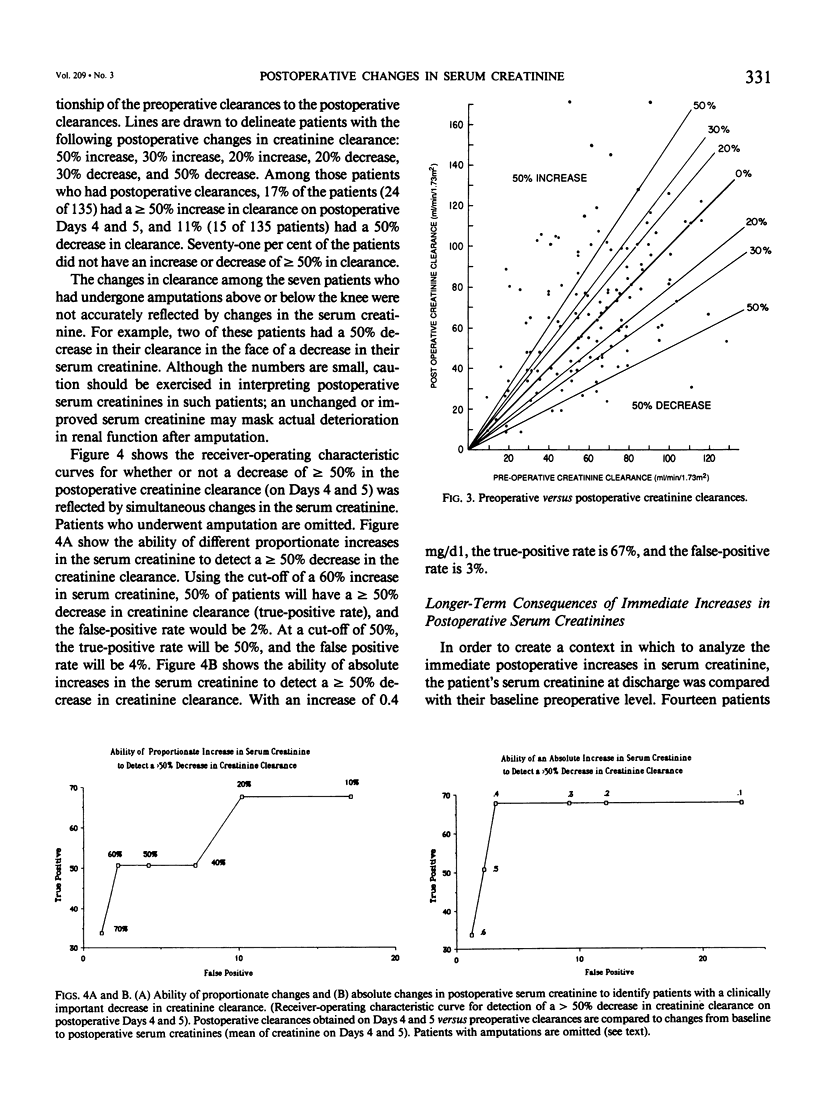
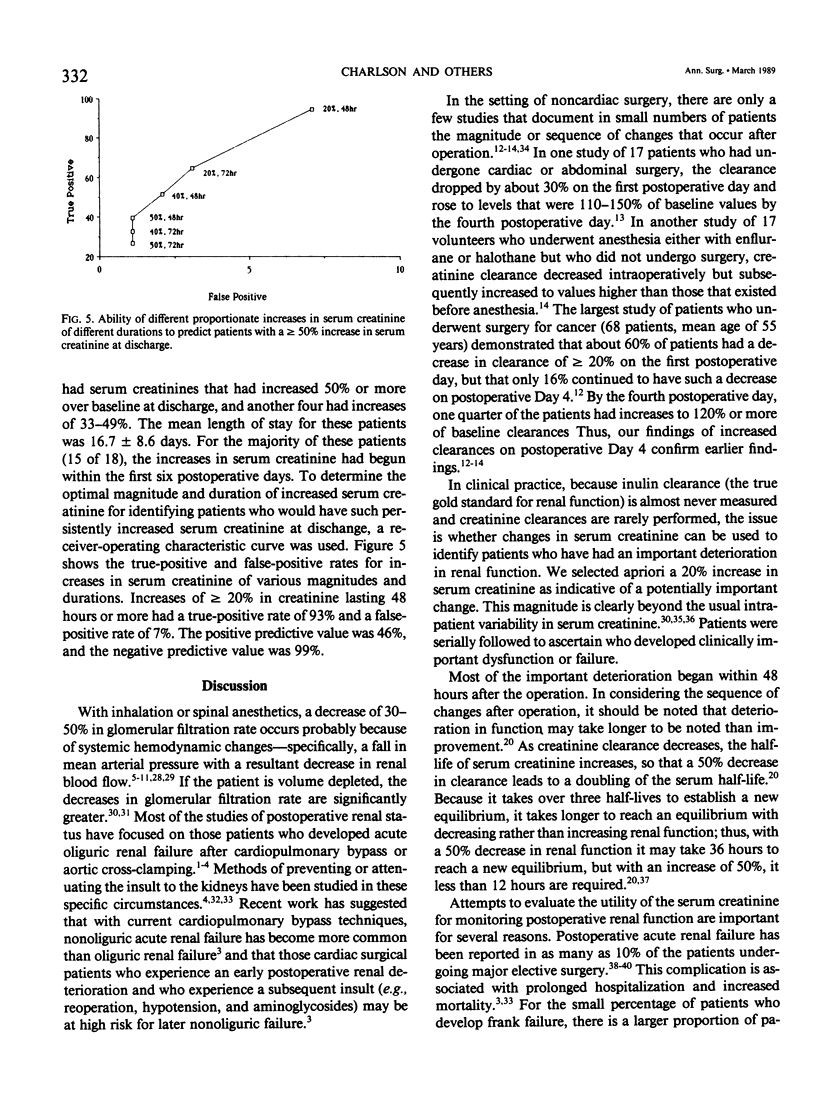
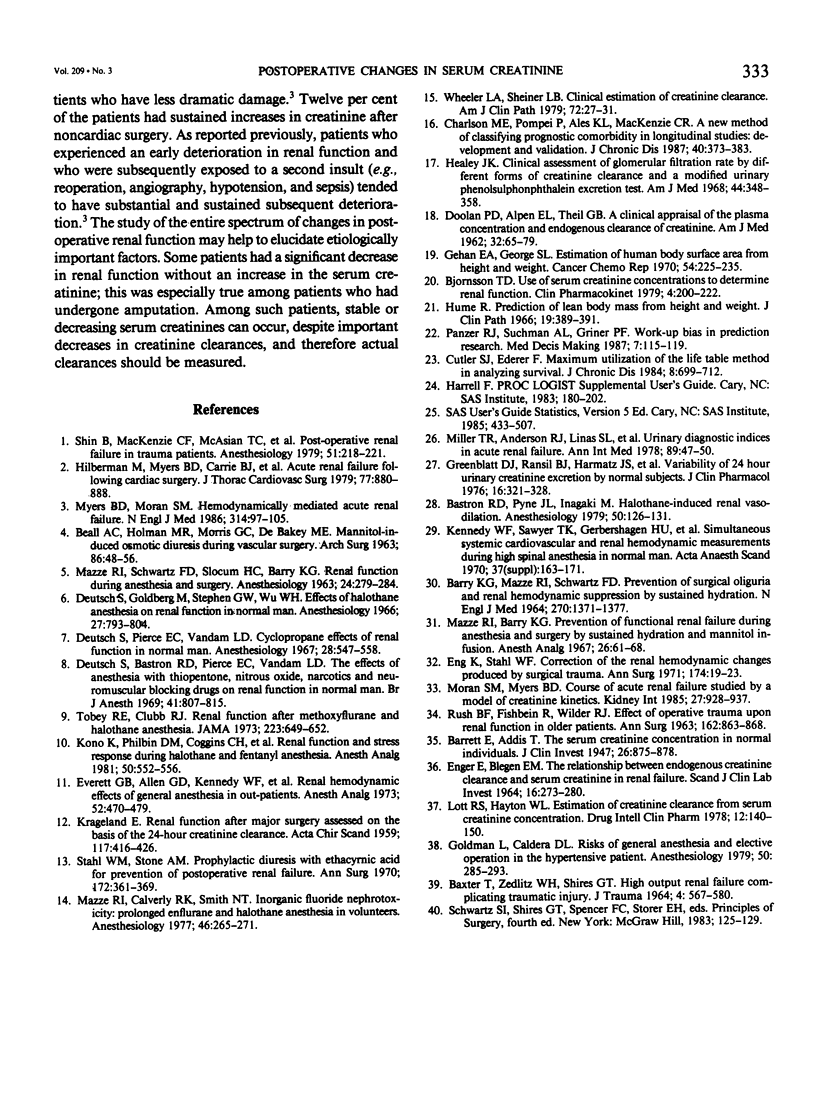
Selected References
These references are in PubMed. This may not be the complete list of references from this article.
- BARRY K. G., MAZZE R. I., SCHWARTZ F. D. PREVENTION OF SURGICAL OLIGURIA AND RENAL-HEMODYNAMIC SUPPRESSION BY SUSTAINED HYDRATION. N Engl J Med. 1964 Jun 25;270:1371–1377. doi: 10.1056/NEJM196406252702601. [DOI] [PubMed] [Google Scholar]
- BAXTER C. R., ZEDLITZ W. H., SHIRES G. T. HIGH OUTPUT ACUTE RENAL FAILURE COMPLICATING TRAUMATIC INJURY. J Trauma. 1964 Sep;4:567–580. doi: 10.1097/00005373-196409000-00002. [DOI] [PubMed] [Google Scholar]
- Barrett E., Addis T. THE SERUM CREATININE CONCENTRATION OF NORMAL INDIVIDUALS. J Clin Invest. 1947 Sep;26(5):875–878. doi: 10.1172/JCI101879. [DOI] [PMC free article] [PubMed] [Google Scholar]
- Bastron R. D., Pyne J. L., Inagaki M. Halothane-induced renal vasodilation. Anesthesiology. 1979 Feb;50(2):126–131. doi: 10.1097/00000542-197902000-00010. [DOI] [PubMed] [Google Scholar]
- Bjornsson T. D. Use of serum creatinine concentrations to determine renal function. Clin Pharmacokinet. 1979 May-Jun;4(3):200–222. doi: 10.2165/00003088-197904030-00003. [DOI] [PubMed] [Google Scholar]
- CUTLER S. J., EDERER F. Maximum utilization of the life table method in analyzing survival. J Chronic Dis. 1958 Dec;8(6):699–712. doi: 10.1016/0021-9681(58)90126-7. [DOI] [PubMed] [Google Scholar]
- Charlson M. E., Pompei P., Ales K. L., MacKenzie C. R. A new method of classifying prognostic comorbidity in longitudinal studies: development and validation. J Chronic Dis. 1987;40(5):373–383. doi: 10.1016/0021-9681(87)90171-8. [DOI] [PubMed] [Google Scholar]
- DOOLAN P. D., ALPEN E. L., THEIL G. B. A clinical appraisal of the plasma concentration and endogenous clearance of creatinine. Am J Med. 1962 Jan;32:65–79. doi: 10.1016/0002-9343(62)90183-3. [DOI] [PubMed] [Google Scholar]
- Deutsch S., Bastron R. D., Pierce E. C., Jr, Vandam L. D. The effects of anaesthesia with thiopentone, nitrous oxide, narcotics and neuromuscular blocking drugs on renal function in normal man. Br J Anaesth. 1969 Oct;41(10):807–815. doi: 10.1093/bja/41.10.807. [DOI] [PubMed] [Google Scholar]
- Deutsch S., Goldberg M., Stephen G. W., Wu W. H. Effects of halothane anesthesia on renal function in normal man. Anesthesiology. 1966 Nov-Dec;27(6):793–804. doi: 10.1097/00000542-196611000-00012. [DOI] [PubMed] [Google Scholar]
- Deutsch S., Pierce E. C., Jr, Vandam L. D. Cyclopropane effects on renal function in normal man. Anesthesiology. 1967 May-Jun;28(3):547–558. [PubMed] [Google Scholar]
- ENGER E., BLEGEN E. M. THE RELATIONSHIP BETWEEN ENDOGENOUS CREATININE CLEARANCE AND SERUM CREATININE IN RENAL FAILURE. Scand J Clin Lab Invest. 1964;16:273–280. doi: 10.1080/00365516409060517. [DOI] [PubMed] [Google Scholar]
- Eng K., Stahl W. M. Correction of the renal hemodynamic changes produced by surgical trauma. Ann Surg. 1971 Jul;174(1):19–23. doi: 10.1097/00000658-197107010-00003. [DOI] [PMC free article] [PubMed] [Google Scholar]
- Everett G. B., Allen G. D., Kennedy W. F., Jr, Gerbershagen H. U., Cutler R. E., Sawyer T. K. Renal hemodynamic effects of general anesthesia in outpatients. Anesth Analg. 1973 May-Jun;52(3):470–479. [PubMed] [Google Scholar]
- Gehan E. A., George S. L. Estimation of human body surface area from height and weight. Cancer Chemother Rep. 1970 Aug;54(4):225–235. [PubMed] [Google Scholar]
- Goldman L., Caldera D. L. Risks of general anesthesia and elective operation in the hypertensive patient. Anesthesiology. 1979 Apr;50(4):285–292. doi: 10.1097/00000542-197904000-00002. [DOI] [PubMed] [Google Scholar]
- Greenblatt D. J., Ransil B. J., Harmatz J. S., Smith T. W., Duhme D. W., Koch-Weser J. Variability of 24-hour urinary creatinine excretion by normal subjects. J Clin Pharmacol. 1976 Jul;16(7):321–328. doi: 10.1002/j.1552-4604.1976.tb01527.x. [DOI] [PubMed] [Google Scholar]
- Healy J. K. Clinical assessment of glomerular filtration rate by different forms of creatinine clearance and a modified urinary phenolsulphonphthalein excretion test. Am J Med. 1968 Mar;44(3):348–358. doi: 10.1016/0002-9343(68)90106-x. [DOI] [PubMed] [Google Scholar]
- Hilberman M., Myers B. D., Carrie B. J., Derby G., Jamison R. L., Stinson E. B. Acute renal failure following cardiac surgery. J Thorac Cardiovasc Surg. 1979 Jun;77(6):880–888. [PubMed] [Google Scholar]
- Hume R. Prediction of lean body mass from height and weight. J Clin Pathol. 1966 Jul;19(4):389–391. doi: 10.1136/jcp.19.4.389. [DOI] [PMC free article] [PubMed] [Google Scholar]
- KRAGELUND E. Renal function after major surgery assessed on the basis of the 24-hour creatinine clearance. Acta Chir Scand. 1959 Sep 20;117:416–426. [PubMed] [Google Scholar]
- Kennedy W. F., Jr, Sawyer T. K., Gerbershagen H. U., Everett G. B., Cutler R. E., Allen G. D., Bonica J. J. Simultaneous systemic cardiovascular and renal hemodynamic measurements during high spinal anaesthesia in normal man. Acta Anaesthesiol Scand Suppl. 1969;37:163–171. doi: 10.1111/j.1399-6576.1970.tb00900.x. [DOI] [PubMed] [Google Scholar]
- Kono K., Philbin D. M., Coggins C. H., Moss J., Rosow C. E., Schneider R. C., Slater E. E. Renal function and stress response during halothane or fentanyl anesthesia. Anesth Analg. 1981 Aug;60(8):552–556. [PubMed] [Google Scholar]
- Mazze R. I., Barry K. G. Prevention of functional renal failure during anesthesia and surgery by sustained hydration and mannitol infusion. Anesth Analg. 1967 Jan-Feb;46(1):61–68. [PubMed] [Google Scholar]
- Mazze R. I., Calverley R. K., Smith N. T. Inorganic fluoride nephrotoxicity: prolonged enflurane and halothane anesthesia in volunteers. Anesthesiology. 1977 Apr;46(4):265–271. [PubMed] [Google Scholar]
- Miller T. R., Anderson R. J., Linas S. L., Henrich W. L., Berns A. S., Gabow P. A., Schrier R. W. Urinary diagnostic indices in acute renal failure: a prospective study. Ann Intern Med. 1978 Jul;89(1):47–50. doi: 10.7326/0003-4819-89-1-47. [DOI] [PubMed] [Google Scholar]
- Moran S. M., Myers B. D. Course of acute renal failure studied by a model of creatinine kinetics. Kidney Int. 1985 Jun;27(6):928–937. doi: 10.1038/ki.1985.101. [DOI] [PubMed] [Google Scholar]
- Myers B. D., Moran S. M. Hemodynamically mediated acute renal failure. N Engl J Med. 1986 Jan 9;314(2):97–105. doi: 10.1056/NEJM198601093140207. [DOI] [PubMed] [Google Scholar]
- Panzer R. J., Suchman A. L., Griner P. F. Workup bias in prediction research. Med Decis Making. 1987 Apr-Jun;7(2):115–119. doi: 10.1177/0272989X8700700209. [DOI] [PubMed] [Google Scholar]
- Rush B. F., Fishbein R., Wilder R. J. Effect of Operative Trauma Upon Renal Function in Older Patients. Ann Surg. 1965 Nov;162(5):863–868. doi: 10.1097/00000658-196511000-00007. [DOI] [PMC free article] [PubMed] [Google Scholar]
- Shin B., Mackenzie C. F., McAslan T. C., Helrich M., Cowley R. A. Postoperative renal failure in trauma patients. Anesthesiology. 1979 Sep;51(3):218–221. doi: 10.1097/00000542-197909000-00007. [DOI] [PubMed] [Google Scholar]
- Stahl W. M., Stone A. M. Prophylactic diuresis with ethacrynic acid for prevention of postoperative renal failure. Ann Surg. 1970 Sep;172(3):361–369. doi: 10.1097/00000658-197009000-00006. [DOI] [PMC free article] [PubMed] [Google Scholar]
- Tobey R. E., Clubb R. J. Renal function after methoxyflurane and halothane anesthesia. JAMA. 1973 Feb 5;223(6):649–652. [PubMed] [Google Scholar]
- Wheeler L. A., Sheiner L. B. Clinical estimation of creatinine clearance. Am J Clin Pathol. 1979 Jul;72(1):27–32. doi: 10.1093/ajcp/72.1.27. [DOI] [PubMed] [Google Scholar]


